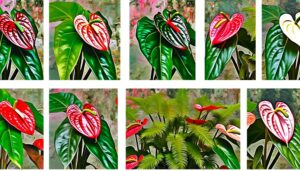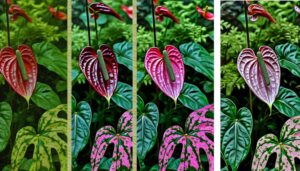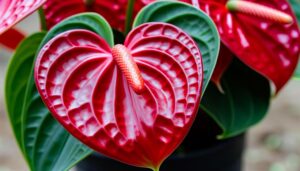Unique Features of Anthurium Thai Hybrid Variegata: A Guide!
You’ll find that the Anthurium Thai Hybrid Variegata is unique due to its intricate variegated leaf patterns resulting from genetic mutations affecting chlorophyll distribution. Each leaf exhibits a distinct mosaic of green and white, showcasing the plant’s complex genetic background.
It’s also highly adaptable, thriving in varying light and moisture conditions, and demonstrating impressive growth rates. Ideal light conditions are bright and indirect, with 600-800 foot-candles of light and 60-80% humidity for best foliage health.
For potting, use a well-draining mix with orchid bark, perlite, and peat moss. Dive deeper into care practices to support your plant’s thriving.
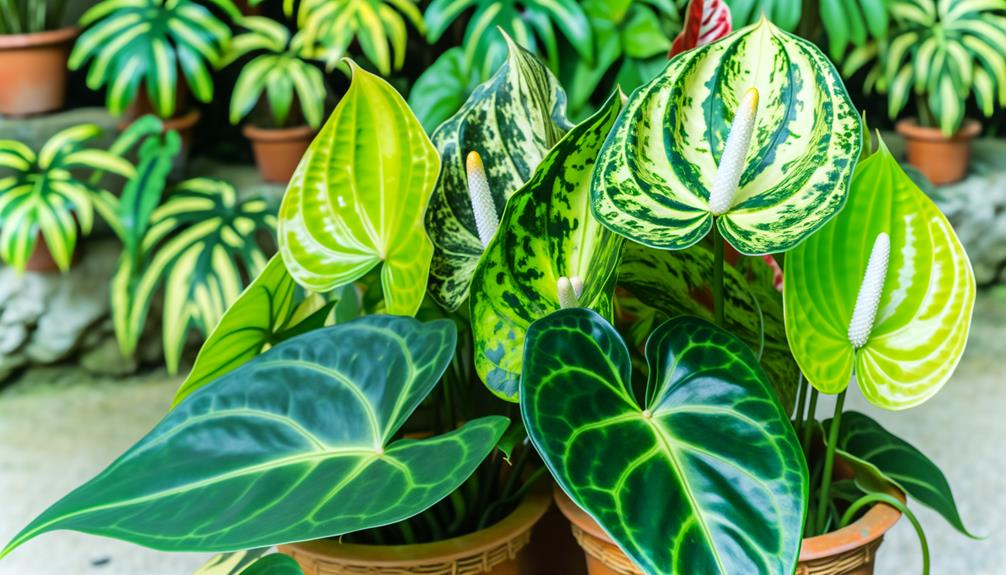
Key Takeaways
- Variegated leaf patterns result from genetic mutations affecting chlorophyll distribution, making each leaf unique.
- Green sections contain chlorophyll for photosynthesis, while white areas lack chlorophyll, affecting photosynthesis capacity.
- The plant adapts to varying light and moisture conditions, demonstrating impressive growth and resilience.
- Anthurium Thai Hybrid Variegata showcases a distinct mosaic pattern, enhancing its aesthetic appeal.
- The plant’s root system is highly efficient, supporting rapid nutrient absorption and vigorous growth.
Variegated Leaf Patterns
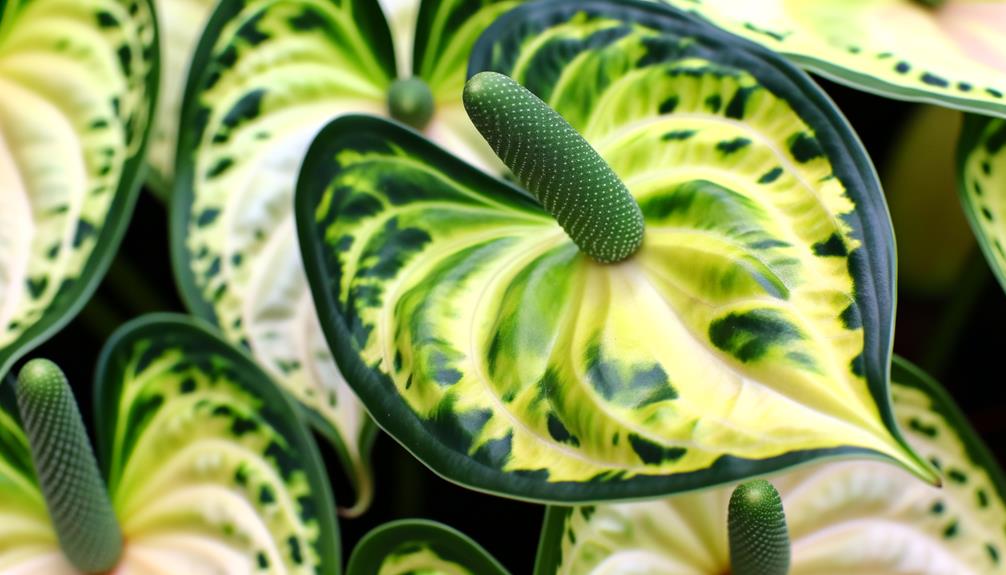
Variegated leaf patterns in Anthurium Thai Hybrid Variegata exhibit a striking combination of green and white patches, resulting from genetic mutations that affect chlorophyll distribution.
You’ll notice that these patterns aren’t random; they follow a specific arrangement dictated by cell lineage and genetic factors. Each leaf showcases a unique mosaic, making every plant distinct.
The green areas contain chlorophyll, facilitating photosynthesis, while the white sections lack chlorophyll, leading to reduced photosynthetic capacity.
This variegation not only enhances aesthetic appeal but also indicates the plant’s complex genetic background.
Growth and Adaptability
In its native tropical habitat, the Anthurium Thai Hybrid Variegata thrives due to its robust adaptability to varying light and moisture conditions.
You’ll find this plant’s growth rate impressive, as it can rapidly produce lush foliage under ideal circumstances. Its root system is highly efficient, allowing it to absorb nutrients quickly and support vigorous growth.
This hybrid’s resilience to fluctuating temperatures and humidity levels makes it ideal for diverse environments.
You won’t need to worry about it being overly sensitive to minor changes. Its ability to adapt contributes significantly to its overall hardiness, ensuring it remains healthy even when conditions aren’t perfect.
Embrace the freedom to experiment with different settings, knowing your Anthurium will continue to flourish.
Light and Water Needs
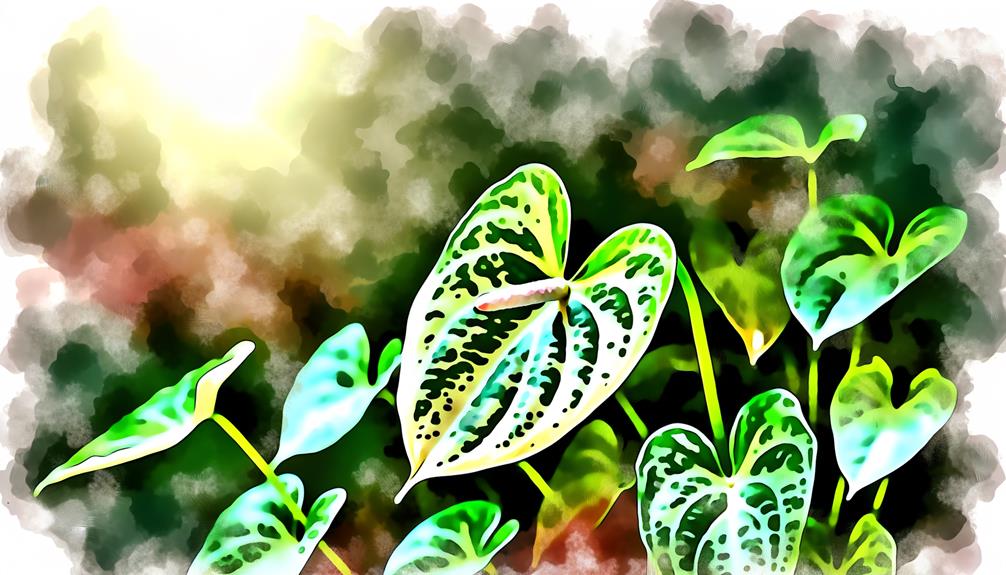
To achieve best development, place your Anthurium Thai Hybrid Variegata in bright, indirect light and maintain a consistent watering schedule. Direct sunlight can scorch its leaves, while too little light will stunt growth.
Follow these steps for prime care:
- Light Intensity: Ensure your plant receives 600-800 foot-candles of light. Use a light meter to measure this accurately.
- Watering Frequency: Water when the top inch of soil feels dry. Overwatering leads to root rot, so use well-draining pots.
- Humidity Levels: Keep humidity around 60-80%. Employ a humidifier or place a water tray nearby to maintain this.
Soil and Potting Mix
For best development, choose a well-ventilated, chunky potting mix that guarantees exceptional drainage and retains necessary moisture.
You’ll want to combine orchid bark, perlite, and peat moss in equal parts. This mixture ensures the roots have ample oxygen, reducing the risk of root rot. Adding charcoal can further improve aeration and keep the soil fresh.
Avoid dense or compacted soils that can suffocate the roots and hinder growth. Use a pot with drainage holes to prevent waterlogging. Repot every 1-2 years to refresh the soil and accommodate growth.
Common Pests and Diseases

You should be watchful about spider mites and aphids, which can cause significant damage to your Anthurium Thai Hybrid Variegata. Regularly inspect the leaves for tiny webs or clusters of insects.
To prevent root rot, maintain proper drainage and avoid overwatering, as the roots are particularly susceptible to fungal infections.
Spider Mites and Aphids
When cultivating Anthurium Thai Hybrid Variegata, careful monitoring for spider mites and aphids is crucial due to their tendency to cause significant damage to the plant.
Spider mites, minute and often unnoticed, feed on the plant’s sap, resulting in stippling and leaf discoloration.
Aphids, conversely, excrete honeydew, encouraging sooty mold growth that can additionally stress the plant.
To effectively manage these pests, you should:
- Inspect regularly: Check both the upper and lower sides of leaves for early signs of infestation.
- Apply insecticidal soap: Utilize a targeted approach to eliminate pests without harming the plant.
- Maintain humidity: Adequate humidity levels can deter spider mites and decrease their proliferation.
Stay proactive to guarantee your Anthurium thrives.
Root Rot Prevention
Regularly ensuring proper drainage and avoiding waterlogged conditions are essential steps in preventing root rot in Anthurium Thai Hybrid Variegata.
Use a well-draining potting mix, such as one containing peat, perlite, and orchid bark. Water the plant only when the top inch of soil feels dry.
Here’s a quick reference table for root rot prevention:
| Prevention Method | Details |
|---|---|
| Proper Drainage | Use pots with drainage holes |
| Well-Draining Soil | Include peat, perlite, orchid bark |
| Watering Schedule | Water only when top inch is dry |
| Avoid Overwatering | Let soil dry out between waterings |
| Regular Monitoring | Check roots periodically |
Consistently following these strategies will keep the roots healthy and your plant thriving.
Propagation Methods
To propagate Anthurium Thai Hybrid Variegata, you’ll need to master three key techniques: stem cutting, root division, and air layering. Each method requires specific steps and conditions to guarantee successful growth.
Start by selecting healthy parent plants and proper tools for clean and efficient propagation.
Stem Cutting Techniques
Stem cutting techniques for propagating Anthurium Thai Hybrid Variegata require precise execution to guarantee successful root development and plant growth. To achieve this, follow these steps:
- Select a Healthy Stem: Choose a stem with at least two nodes and a few leaves. Make sure it’s free of disease and pests.
- Make a Clean Cut: Use sterilized scissors or a sharp knife to make a clean cut just below a node. The cut should be diagonal to increase the surface area for root growth.
- Prepare for Rooting: Dip the cut end in rooting hormone to stimulate root development. Place the cutting in a well-draining medium like sphagnum moss or perlite, and maintain high humidity and indirect light conditions.
Root Division Steps
After mastering stem cutting techniques, you can also propagate Anthurium Thai Hybrid Variegata through root division.
This method involves separating the plant‘s root mass to create new, independent plants. Begin by carefully removing the plant from its pot and gently shaking off excess soil.
Identify natural separations or clumps in the root system. Using a sterilized knife or shears, cut the root mass into sections, validating each section has viable roots and at least one healthy shoot. Dust the cut areas with fungicide to prevent infection.
Replant each section in a well-draining mix, and water thoroughly. Make sure they’re placed in a humid, warm environment to encourage root development. Monitor closely for signs of new growth.
Air Layering Process
Air layering offers a precise method to propagate Anthurium Thai Hybrid Variegata by promoting root formation on a stem while it’s still attached to the parent plant. To start, you’ll need to select a healthy stem.
Here’s how to do it:
- Wound the Stem: Make a small, upward cut on the stem, about one-third through.
- Apply Rooting Hormone: Dust the cut area with rooting hormone to stimulate root growth.
- Wrap with Moss: Cover the wounded area with moist sphagnum moss and secure it with plastic wrap.
Make sure the moss stays moist by misting it regularly.
Once roots develop, usually after a few weeks, you can cut the stem below the new roots and plant it. This method guarantees robust, independent plants.
Conclusion
In nurturing your Anthurium Thai Hybrid Variegata, you’re not just growing a plant but creating a masterpiece of nature.
Its variegated leaves, like living canvases, demand specific light and water, while thriving in well-draining soil.
Vigilance against pests and diseases guarantees its splendor.
Master propagation, and you’ll multiply this botanical gem.
With precision and care, your Anthurium will flourish, a vivid attestation to your dedication and its inherent beauty.


